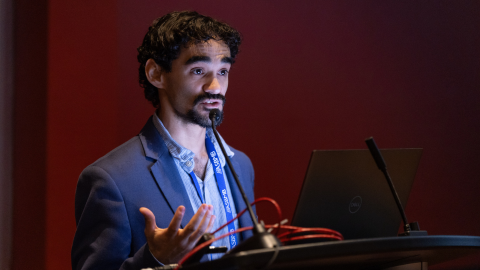Navigating the NIH grant-application process
If your career goal is to perform biomedical research, then you should read this article. Here, I’ll try to help you navigate the grant application and review process and hopefully guide you to a successful submission. I will address only applications to the National Institutes of Health, because, frankly, this is what I know. There are many more funding agencies, but the NIH is where the bulk of the money is.
The NIH has a complex organizational structure made up of institutes or divisions with their own research interests. When the application is submitted, it is first reviewed by the Center for Scientific Review; based on the content of the abstract, a program officer at the CSR assigns the grant to an Integrated Review Group (a study section) and an institute or center. If you want your application to be assigned to a specific institute or study section, make sure the first or last sentences of the abstract have keywords aligned with those research interests. There may be some overlap between study sections, and you are allowed to request a study section in the cover letter.
About two to three months after submission, the Scientific Review Groups evaluate the scientific merit of the grant. After another two to three months, an advisory council or board recommends the grant for approval. After approval, the institute staff prepares a funding plan for the director, the institute allocates the funds and the grantee begins conducting his or her research.

Writing a cover letter to request a study section
Your cover letter should include the following:
- application title,
- institute request (it’s best to choose three, but you need to prioritize ),
- IRG request (get advice from your program officer on this), and
- any other special requests.
Having your application assigned to the right study section ensures that the appropriate people review your application. The NIH generally honors requests for study sections. It is important to frame your request in positive terms. Mentioning that a study section has several people interested in your area and qualified to judge your work is essential. While gathering the information to make an informed request takes work, many investigators feel it’s worth it. Research the interests of each study section to see where your application would fit best, and look at review rosters to see who is on the committees. Remember that it is not easy to tell who will review the application, because many applications are now reviewed by fluid ad-hoc, special-emphasis panels.
Meeting deadlines
The NIH has three grant cycles that may vary depending on the type of grant. It is important to observe the deadlines. If your grant is submitted after the deadline, it may not be reviewed until the next review cycle. Find grant deadline information here.
Strategies for planning a grant
Write an outstanding application that will appeal to reviewers, who serve as judge and jury. Write from the perspective of a screenwriter and not from the perspective of a novelist. A grant is presented to a panel of peer reviewers by one primary person and two helpers, so you want to write a script that will facilitate presentation of your proposal to the rest of the panel.
There are eight main steps to follow when planning your grant.
-
Check out the competition and see which projects in your field are being funded. Search the NIH RePORTER database.
-
Evaluate yourself: How do your strengths match the topics found in step 1? Can you capitalize on your expertise and fill in gaps with mentors, collaborators or consultants? Do you have a niche? If not, find one!
- Determine available resources and support from your school.
- Brainstorm with colleagues and mentors, and have knowledge of the relevant literature!
- 5) Write a hypothesis for your proposal in 25 words or fewer; edit, edit and then edit again.
- Give yourself time to write and rewrite the application.
- Utilize any form of pre-peer review that you can find (e.g., a mock study section, a class).
- Follow all instructions to the letter: Poor formatting, illegible figures, wrong fonts and poor grantsmanship will turn reviewers off!
Writing a solid hypothesis
Most top-notch grant applications are driven by strong hypotheses rather than advances in technology. Applications should ask questions that prove or disprove a hypothesis rather than use a method to search for a problem or simply collect information. If your application is not hypothesis-based, state that it isn’t and give your reasons why the work is important (e.g., X-ray crystallography, or perhaps it’s a training grant). Choose an important, testable, focused hypothesis that increases understanding of biological processes, diseases, treatments or preventions. A strong hypothesis should be based on previous research. Reiterate your hypothesis throughout the grant using different wording.
Planning your application
Ask yourself these questions: Why is this project important? Why are you the right person to conduct this research?
Required sections of a grant are “Specific Aims” (one page long) and “Research Strategy” (the new format has a 12-page maximum).
“Specific Aims” should include the following:
- One to two paragraphs that develop the conceptual framework of the proposal. These should describe previous studies in the area, identify the gaps the research will address and end with a statement of your hypothesis or overall objective.
- A set of aims designed to answer the questions posed by the hypothesis. The important word here is “specific”! Each aim should be a specific test of the overall hypothesis. Organize and define your aims so that you can relate them directly to your research strategy.
The “Research Strategy” section includes the following
- Significance
a. Explain the importance of the problem or critical barrier to progress in the field that the project will address.
b. Explain how the project will improve scientific knowledge, technical capability and/or clinical practice in one or more broad fields.
c. Describe how the concepts, methods, technologies, treatments, services or preventative interventions that drive this field will be changed if the aims are achieved. - Innovation
a. Explain how the application challenges and seeks to shift research or clinical-practice paradigms.
b. Describe novel theoretical concepts, approaches or methodologies, and instrumentation or intervention(s) to be developed or used and any advantage over existing methodologies, instrumentation or intervention(s).
c. Explain refinements, improvements or new applications of theoretical concepts, approaches or methodologies, instrumentation, or interventions. - Approach
a. Describe the overall strategy, methodology and analyses to be used to accomplish the specific aims. Provide evidence of feasibility – not a miniature version of the proposed study.
b. Discuss potential problems, alternative strategies and benchmarks for success anticipated.
Crafting your biographical sketch
The bio sketch requires a personal statement that briefly describes why your experience and qualifications make you particularly well suited for your role in the project.
Having your application scored
The IRG will review your application and assign it a score from 1 to 9. A score of 1 is the highest, given to a grant considered exceptionally strong with essentially no weaknesses; 9 is considered poor, with very few strengths and numerous major weaknesses.
In summary, a great proposal is a solid, exciting idea that is well expressed with a clear indication of methods for pursuing the idea, evaluating the findings, making them known to all who need to know and — for the NIH — indicating the overall impact to the scientific community.
Watch the video below from the NIH Center for Scientific Review for tips for new grant applicants.
Enjoy reading ASBMB Today?
Become a member to receive the print edition four times a year and the digital edition monthly.
Learn moreFeatured jobs
from the ASBMB career center
Get the latest from ASBMB Today
Enter your email address, and we’ll send you a weekly email with recent articles, interviews and more.
Latest in Careers
Careers highlights or most popular articles

Upcoming opportunities
Apply for the ASBMB Interactive Mentoring Activities for Grantsmanship Enhancement grant writing workshop by April 15.

Quieting the static: Building inclusive STEM classrooms
Christin Monroe, an assistant professor of chemistry at Landmark College, offers practical tips to help educators make their classrooms more accessible to neurodivergent scientists.

Unraveling oncogenesis: What makes cancer tick?
Learn about the ASBMB 2025 symposium on oncogenic hubs: chromatin regulatory and transcriptional complexes in cancer.

Exploring lipid metabolism: A journey through time and innovation
Recent lipid metabolism research has unveiled critical insights into lipid–protein interactions, offering potential therapeutic targets for metabolic and neurodegenerative diseases. Check out the latest in lipid science at the ASBMB annual meeting.

Hidden strengths of an autistic scientist
Navigating the world of scientific research as an autistic scientist comes with unique challenges —microaggressions, communication hurdles and the constant pressure to conform to social norms, postbaccalaureate student Taylor Stolberg writes.

Upcoming opportunities
The countdown to #ASBMB25 is on! Visit our annual meeting website to start adding special sessions, keynote lectures, scientific symposia and more to your personal schedule.

